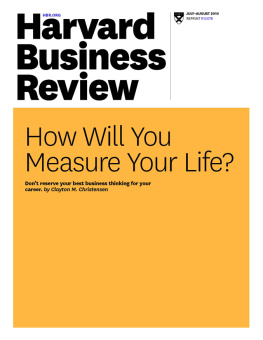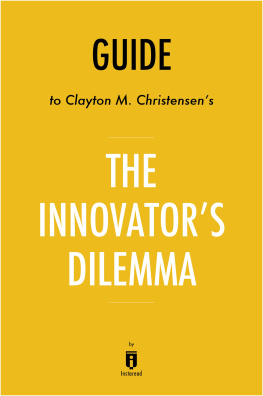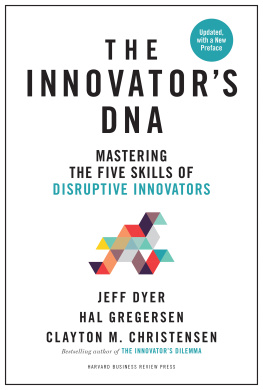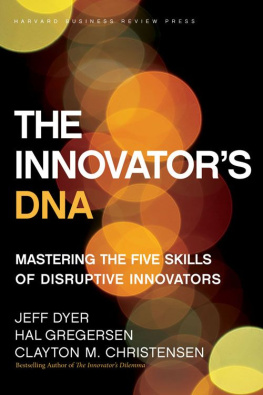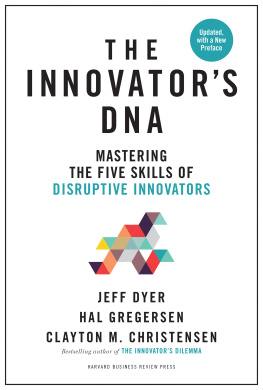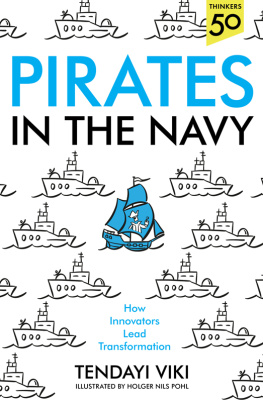LEAD AND DISRUPT
How to Solve the Innovators Dilemma
Charles A. OReilly III and Michael L. Tushman
STANFORD BUSINESS BOOKS
An Imprint of Stanford University Press
Stanford, California
Stanford University Press
Stanford, California
2016 by the Board of Trustees of the Leland Stanford Junior University.
All rights reserved.
No part of this book may be reproduced or transmitted in any form or by any means, electronic or mechanical, including photocopying and recording, or in any information storage or retrieval system without the prior written permission of Stanford University Press.
Special discounts for bulk quantities of Stanford Business Books are available to corporations, professional associations, and other organizations. For details and discount information, contact the special sales department of Stanford University Press. Tel: (650) 736-1782, Fax: (650) 725-3457
Printed in the United States of America on acid-free, archival-quality paper
Library of Congress Cataloging-in-Publication Data
Names: OReilly, Charles A., author. | Tushman, Michael, author.
Title: Lead and disrupt : how to solve the innovators dilemma / Charles A. OReilly III and Michael L. Tushman.
Description: Stanford, California : Stanford Business Books, an imprint of Stanford University Press, 2016. | Includes bibliographical references and index.
Identifiers: LCCN 2015050235| ISBN 9780804798655 (cloth : alk. paper) | ISBN 9780804799492 (electronic)
Subjects: LCSH: Technological innovationsManagement. | Success in business.
Classification: LCC HD45 .O72945 2016 | DDC 658.4/063dc23
LC record available at http://lccn.loc.gov/2015050235
Typeset by Bruce Lundquist in 11.75/16 Baskerville
This book is dedicated to Ulrike and Marjorie Rose
CONTENTS
PREFACE AND ACKNOWLEDGMENTS
This book represents our attempt to solve a mystery that has fascinated us for almost two decades. As researchers and sometimes as consultants, we have had the opportunity to interact with quite a few organizations, their managers, and their leaders. Most of these organizations had a strategic vision. They possessed immense financial capital. And they were filled with smart, hard-working people. Yet as we watched these firms over time, they often struggled in the face of innovation and change. For many, their inability to adapt as industries shifted was disastrous. As we reflected on these trials, it was clear to us that most of the problems these firms faced were not from a lack of insight or resources. The question that kept coming up was, Why do successful firms find it so difficult to adapt in the face of changeto innovate? The answer, we concluded, does not hinge on strategy or technology or even luckas important as these factors may be. Rather, it has everything to do with leadershipand how leaders act in the face of change.
In the past ten years, the importance of this question has increased as more industries and firms confront disruptive change. Fifty years ago, the average life expectancy of a firm in the Standard and Poors 500 was fifty years. Today it is closer to twelve. This dramatic increase in the rate of corporate failure reflects the increasing rate at which disruptive change is occurring. That change is putting immense pressure on leaders to react more quickly than ever before to this type of threat. You have only to look at what has happened in industries as diverse as music, newspapers, health care, retail, and high technology to appreciate the threat that innovation poses for established firms. Fifty years ago, or even twenty, managers had the luxury of time. If they were slow to react to change, they could recover. This is no longer the case. In todays world, firms that miss a transition or fail to respond to a disruptive innovation quickly find themselves out of business. Think about the plight of taxis confronted with ride-sharing firms, or traditional banks confronted by online banking, or department stores facing competition from Amazon, or universities facing low-cost distance learning portals. How should leaders think about these threats? What can they do to avoid being disrupted? How can they respond?
We believe that we have, if not an answer, then at least clear practical insights that can help leaders and managers as they confront disruptive change in their industries and organizations. These insights reflect the hard-learned lessons of leaders across a variety of industries and geographies. Weve been fortunate to spend the last decade working with many of them to confront the issues of innovation and change. To illustrate their lessons learned, we tell the stories of many, both victors and those who were less fortunate, less successful.
As you turn the pages ahead, you will see that what looks to be conceptually simple is often extraordinarily complex in execution. It requires that leaders have an understanding of both what to do and how to do it. It requires them to design organizations that can succeed in mature businesses where success comes from incremental improvement, close attention to customers, and rigorous execution and to simultaneously compete in emerging businesses where success requires speed, flexibility, and a tolerance for mistakes. We refer to this capability as ambidexteritythe ability to do both. If leaders are the linchpin to success, then ambidexterity is the weapon with which they must do battle. Many others have claimed to have the solution to the innovators dilemma. But we believe ambidexterity is the real key. How they work and why is the story we tell here.
Before we proceed, we owe a debt of gratitude to Lou Gerstner, Bruce Harreld, Sam Palmisano, and Carol Kovac at IBM; Tom Curley and Karen Jurgenson at USA Today; T. J. Rodgers and Brad Buss at Cypress Semiconductor; Phil Faraci and Mark Oman at HP; Mike McNamara, Nader Mikhail, and Dave Blonski at Flextronics; Kent Thiry and Josh Golomb at DaVita; Glenn Bradley and Dan Vasella at Novartis; and Anthony Hucker and Mark Tallman at Walmart. Thank you for allowing us to learn from your hands-on experiences of confronting disruptive innovation. We have also learned from watching other leaders, including Jeff Bezos at Amazon, Shigetaka Komori at Fujifilm, Adrianna Cisneros at Cisneros, Jeff Davis at NASA Space Life Sciences, David Jones at Havas, John Winsor at Victors and Spoils, Ganesh Natarajan at Zensar, Ben Verwaayen and Alison Ritchie at BT, Ingrid Johnson at Nedbank, Vince Roche at Analog Devices, Mike Lawrie at Mysis and CSC, and John Chambers at Cisco. All have generously shared with us their insights and experiences. We hope we have represented these accurately in telling your stories.
Beyond these specific leaders, we also have benefited from the constructive feedback of managers who attended the many executive education programs that we have taught at Stanford and Harvard and in companies around the world. These audiences have helped us to understand the nuances of ambidexterity and have corrected the mistakes and omissions we have made. We are particularly grateful to the participants of the Leading Change and Organizational Renewal Program, which we have taught at both Stanford and Harvard for more than twenty years. Many of these participants have volunteered their time and expertise to help us refine our understanding and make the lessons in this book useful to readers.
We have benefited from the wisdom of our academic colleagues. Although we have written this book for practicing managers, a large body of academic research underlies our views on ambidexterity. While we have spared our readers exhaustive (and exhausting) citations to this body of research, this book reflects that empirical scholarship. In particular, we have drawn on the research and comments of Clay Christensen at the Harvard Business School, David Teece at the University of California, Berkeley, Justin Jansen at Erasmus University in Amsterdam, Julian Birkinshaw at the London Business School, Mark Ventresca at the Said Business School, University of Oxford, and David Caldwell at Santa Clara University. These and other colleagues like Wendy Smith at the University of Delaware and Mary Benner at the University of Minnesota have been coauthors and commenters on our work.
Next page


